Up Against The Wall
by Christopher Caile
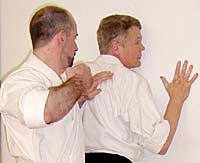
It's not an enviable position — to be pushed from the back into a wall, or up against a car or other object. Shocked by the suddenness of the attack, and back turned to the assailant, most people are totally defenseless.
In bars I've seen people pushed forward into tables and posts, or against the bar, and then struck down from behind. But the backward push is also commonly used in robberies — pushing a woman, for example, against her car in order to rip away her handbag. This was working so well in Buffalo a few years back that I was part of a team that was asked to give several self-defense seminars to federal and state employees. (1)
Escaping a push isn't really that difficult if you practice some simple basics. First thing to remember is not to get "squished," that is, not to let yourself get pushed totally flat into something (as seen in the photo above).
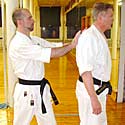

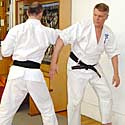
As a push comes, it is only natural to react by extending your arms forward to brace yourself as you also step forward with one leg. Allow your arms to absorb some of the energy that is propelling you forward. This also keeps the body some distance away from the wall or other object so there is some room to maneuver. Then relax the left arm, allowing the left side to pivot inward (still keeping my right hand against the wall to maintain some distance) toward the wall around the right leg. As your left shoulder passes the wall, lower your right arm and move it with your body. The arm in this way will knock the assailant's pushing arm to the inside.
The key here is not to resist the attack, but to move with it, pivoting to let the assailant's own energy propel him into the wall, while you have turned outward to his outside. Your right hand ends up at about his groin level. From this position many things are possible.
One choice is just to flee. But there are many other options. You could simply punch to the side of the head (not shown). If you just want to control the attacker, you can activate an arm bar and take him or her down. As in the photo, you might add a left palm heel strike to the back of the attacker's skull to stun him or her first (this same technique is also used below). You may also use your turning movement to do a left elbow strike to the same target (not shown).
Another option also stems from the same left palm heel strike to the back of the attacker's skull. In this move you do not rotate your body quite as far, so you can move your right hand in front of your opponent to slap or hit upward into the groin. Then grab the pants near the groin (or reach deeply between the legs to grab the belt from the back). Then you can lift with your right arm and push with your left forearm against the front of the opponent's head — propelling him or her backward to the ground. This type of throw usually results in the attacker landing on his side.

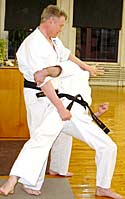

Just the dump into the ground can stun most attackers (especially if there is head contact, so be very careful if you practice this move), but if you desire you may also apply a finishing strike to the side of the attacker's head or jaw. Use your right bent knee against the opponent's hips to keep him or her from turning towards you. Your left arm can also hold the opponent's arm so his or her elbow is locked against your left leg momentarily to help lock your opponent in place.
There is also a happy ending to this article. Remember, we taught this simple turn and escape (and other self-defense techniques) to federal and state employees in Buffalo. Not long afterward we were informed of the results. In the month preceding our seminar five female employees had been assaulted and robbed outside the Federal Building by assailants who had first pushed their victims against their cars in order to tear away their purses. In the month afterwards, we were told, there were four similar attacks, but none were successful. I think it goes without saying that we were invited back for more seminars.
Footnote:
(1) The Seminar team included an aikido teacher Mike Hawley, a judo teacher and fellow aikido-ka, Eric Joseph and myself as a karate teacher and aikido-ka. We taught technique. A volunteer Buffalo police lieutenant also lectured on awareness and how to avoid getting attacked. As a group we taught similar seminars to many corporations and groups in Buffalo and the greater Erie County. In the seminars this technique was taught by Hawley Sensei (Wadokai Aikido) and it comes from aikido. The technique was so impressive and effective that I incorporated it into my own vocabulary of self-defense.

About the Author Christopher Caile
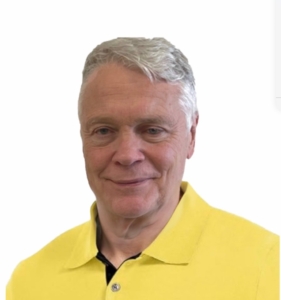
Screenshot
Christopher Caile is the Founder and Editor-In-Chief of FightingArts.com. He has been a student of the martial arts for over 65 years.
He first started in judo while in college. Then he added karate as a student of Phil Koeppel in 1959 studying Kempo and Wado-Ryu karate. He later added Shotokan Karate where he was promoted to brown belt and taught beginner classes. In 1960 while living in Finland, Caile introduced karate to that country and placed fourth in that nation's first national judo tournament.
Wanting to further his karate studies, Caile then hitch hiked from Finland to Japan traveling through Scandinavia, Europe, North Africa, the Middle East and South and Southeast Asia — living on 25 cents a day and often sleeping outside.
Arriving in Japan (1962), Caile was introduced to Mas Oyama and his fledgling full contact Kyokushinkai Karate by Donn Draeger, the famous martial artist and historian. Donn also housed him with several other senior international judo practitioners. Donn became Caile's martial arts mentor, coaching him in judo and introducing him to Shinto Muso-ryu under Takaji Shimizu.
Caile studied at Oyama's honbu dojo and also at Kenji Kurosaki's second Tokyo Kyokushinkai dojo. In his first day in class Oyama asked Caile to teach English to his chief instructor, Tadashi Nakamura. They have been friends ever since. Caile also participated in Oyama's masterwork book, "This Is Karate."
Caile left Japan with his black belt and designation as Branch Chief, the first in the US to have had extensive training in Japan directly under Oyama Sensei. As such, Oyama Sensei asked him to be his representative on visits to his US dojos to report on their status.
A little over a year later, Nakamura, Kusosaki and Akio Fujihira won an epic David vs. Goliath challenge match against Thailand's professional Muay Thai Boxers in Bangkok, Thailand, thrusting Kyolushinkai and Nakamura into national prominence.
Back in the US Caile taught Kyokushinkai karate in Peoria, Il while in college and later in Washington, DC. while in graduate school. Durimg this time Shihan Nakamura had moved to New York City to head Kyokushinkai's North American Operation.
In 1976 when Kaicho Tadashi Nakamura formed the World Seido Karate organization, Caile followed. Living then in Buffalo, NY, Caile taught Seido karate and self-defense at the State University of New York at Buffalo (SUNY Buffalo) for over 15 years where he also frequently lectured on martial arts and Zen in courses on Japanese culture.
Caile moved to New York City in 1999 to marry Jackie Veit. He is now an 8th degree black belt, Hanshi, training in Seido Karate's Westchester, NY Johshin Honzan (Spiritual Center) dojo. In Seido Caile is known for his teaching of and seminars on kata applications. He also produced a 14 segment video series on Pinan kata Bunkai currently available to Seido members.
Caile is also a long-time student and Shihan in Aikido. He studied in Buffalo, under Mike Hawley Shihan, and then under Wadokai Aikido's founder, the late Roy Suenaka (uchi deshi under Morihei Ueshiba, founder of Aikido and was Shihan under Tohei Sensei). In karate, Suenaka (8thdan) was also an in-house student of the Okinawan karate master Hohan Soken.
Having moved to New York City, Caile in 2000 founded this martial arts educational website, FightingArts.com. Twenty-five years later, in 2025, it underwent a major update and revision.
For FightingArts.com and other publications Caile wrote hundreds of articles on karate, martial arts, Japanese art, Chinese Medicine and edited a book on Zen. He also developed relationships with a cross section of leading martial arts teachers. Over the last four decades he has conducted extensive private research into karate and martial arts including private translations of the once secret Okinawan hand copied and passed on Kung Fu book, the Bubishi, as well as an early karate book by the karate master Kenwa Mabuni. He periodically returns to Japan and Okinawa to continue his studies and participate Seido karate events. In Tokyo he practiced (with Roy Suenaka Sensei) in a variety of aikido organizations with their founders – including private interviews and practices at the Aiki-kai Aikido Honbu dojo with the son and grandson of aikido's founder, Doshu (headmaster) Kisshomaru (an old uchi-deshi friend) and his son, Moriteru Ueshiba and in Iwama with Morihiro Saito. On Okinawa he studied Goju Ryu karate under Eiichi Miyazato, 10th dan founder of Naha's Jundokan, and also with Yoshitaka Taira (who later formed his own organization, who specialized in kata Bunkai. While there Caile also trained with Hohan Soken's senior student, Master Fusei Kise, 10 dan as well as with the grandson of the legendary karate master Anko Itosu.
Caile's other martial arts experience includes: Diato-ryu Aikijujitsu and Kenjitsu, kobudo, boxing, Muay Thai, MMA, Kali (empty hand, knife and bolo), study of old Okinawan Shoran-ryu & Tomari body mechanics, study of old Okinawan kata under Richard Kim, study of close quarter defense and combat, including knife and gun defenses, Kyusho Jitsu and several Chinese fighting arts including 8 Star Praying Mantis, Pak Mei (White Eyebrow), and a private family system of Kung Fu.
Caile is also a student of Zen as well as a long-term student of one branch of Traditional Chinese Medicine, Chi Kung (Qigong). As one of two senior disciples of Chi Kung master Dr. Shen (M.D., Ph.D.) Caile was certified to teach and practice. This led to Caile's founding of the The Chi Kung Healing Institute on Grand Island, NY. In Western NY, he also frequently held Chi Kung seminars, including at SUNY Buffalo and at the famous Chautauqua Institution in Chautauqua, NY. His articles on Chi Kung also appeared in the Holistic Health Journal and in several books on alternative medicine.
Caile holds a BA in International Studies from Bradley University and MA in International Relations with a specialty in South and Southeast Asia from American University in Washington, D.C. While in Buffalo, NY he also studied digital and analog electronics.
In his professional life Caile also worked in public relations and as a newspaper reporter and photographer. Earlier he worked in the field of telecommunications including Managing a Buffalo, NY sales and service branch for ITT. He then founded his own private telephone company. This was followed by creation of an electrical engineering company that designed and patented his concept for a new type of low-cost small business telephone system (which was eventually sold to Bell South). The company also did contract work for Kodak and the US space program. Simultaneously Caile designed and manufactured a unique break-apart portable pontoon boat.
Most recently Caile co-founded an internet software company. Its products include software suites with AI capability for control and management of streaming media, such as video and music, an all-in-one book publishing software product for hardcover, eBook and audio book creation and security software for buildings and government use.
For more details about Christopher Caile's martial arts, work experience and life profile, see the About section in the footer of this site.
Search for more articles by this author:







